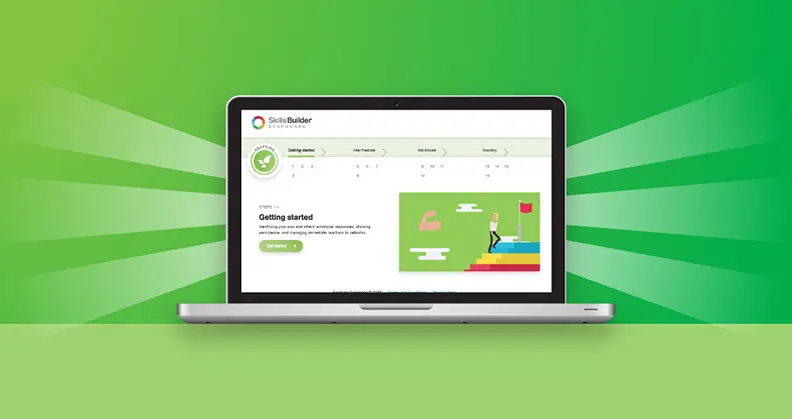As educators, we are tasked with not only ensuring our learners grasp the curriculum but to nurture holistic development of their skills throughout their educational journey. From early years to secondary, apprenticeships and university, one of these vital skills for a learner’s success [1] in life is learning, practising and developing their leadership skills.
This skill is relevant not only for those in positions of management, but also for learners leading in teams for a project, for example. We know that leadership is defined by supporting, encouraging and developing others to achieve a shared goal – so where do we start?
To lay the foundations for effective leadership skills, we need to teach the building blocks of empathy. Learners should be able to understand exactly how they feel about things and how to communicate them in an appropriate way to others. Then, they can use this to recognise how others are feeling and how to respond to them appropriately.
Helping learners understand their feelings
To get started we can help learners identify whether their feelings towards something are simply ‘positive’ or ‘negative’. Emotions can vary throughout the school day and can have a significant impact on concentration and learning. So, it is important to be able to recognise how they feel and give it a name.
Learners of any age may have initial reservations when it comes to sharing their emotions, so we can remove this barrier by firstly posing the following questions to the class for their feedback. For example, feeling positive:
- “What do positive emotions mean for us?” These emotions make people feel good.
- “Can you give me examples of different positive emotions?” Happy, excited, calm.
- “How would someone know when they are feeling positive?” They want to continue to feel like this.
An additional activity to begin developing their leadership skills can be to pick a fictional character in their favourite story or a film. You can then ask them to make a poster or a character profile with the following instructions:
- Pick whether the character was feeling positive or negative
- Describe or draw what different types of positive/negative emotions they were feeling
- Write how you knew the character felt this way. E.g. what facial expressions/actions were they displaying?
- What caused them to feel these emotions?
The class can reflect on these activities by collating them on a mind-map and displaying it in the classroom and/or in their workbooks as a teaching resource. They can then be referred back to as learners progress through their leadership skills across the academic year.
Learners can have an emotional response before they have time to think about what has happened. Teaching resources like those suggested will inform the range of their emotions, begin to encourage them to reflect on how others react and build confidence into eventually applying these strategies to their own responses.
Encouraging learners to share their feelings
There may also be learners who are very willing to express their emotions. Whether these are positive or negative, the key starting point is ensuring everyone has a shared understanding of why it is important to share their feelings:
Sharing positive feelings
- Others might feel encouraged and feel more positive about something with us
- Others can see the positive side of something when we originally felt negative about it
Sharing negative feelings
- Others can support to understand our situation better or support us with the problem we might have
- Others can understand why we feel this way that they may not have known before
- Others might also share their views and feel the same way as us
We can facilitate this step of leadership with a ‘think-pair-share’ activity. Pairs can be randomly allocated the importance of sharing positive or negative feelings to brainstorm their ideas before sharing back with the class. They can then add any differing ideas from their peers to their own lists to consolidate their learning. For younger learners, these prompts can be differentiated for groups to arrange into the ‘sharing positive feelings’ and ‘sharing negative feelings’ piles respectively.
The do’s and don'ts of sharing feelings
At school, learners may find it difficult to convey their feelings in a manner that results in positive outcomes for them and their team members – especially when these feelings are ‘negative’ and can manifest into poor behaviours, ones that they recognise as part of the behaviour policy. Nevertheless, sharing these feelings are more important than not sharing them at all.
However, we can guide them to provide more effective responses with the following guidance:
- Do: Think before you speak. As we know, learners can have an immediate emotional response that influences their resulting actions and words. Encourage them to take a moment to think about why they are experiencing those feelings first.
- Do: Try your best to explain why you feel this way. Reassure learners that this can be difficult but will inform others on how to best help them.
- Don’t: Rely on physical responses. Especially when learners are upset, we can direct them to recognise that behaviours such as aggression won’t help others understand their feelings and can lead to further upset in the group.
- Don’t: Avoid speaking to someone entirely. This can be tricky for those who are upset. Reassure learners that this can be difficult but will help others how to resolve their problem.
To bring this to life, learners can apply what they’ve learned to scenarios outside of school, thus giving them the opportunity to reflect on any differences in their responses and how their leadership skills may differ.
Give them two situations: The first, to think about a time when they were upset by the actions of someone else.
What was that person feeling? How did they show that emotion? How did the learner feel about the situation?
Secondly, ask them to think about an event that was exciting or enjoyable. How did they feel at the time and how did they show this emotion? Did they share their enthusiasm with others? Were others feeling the same?
Teaching empathy
So far, we have covered the foundations of developing effective leadership with learners including: the difference between positive and negative feelings, the importance of sharing feelings and how to appropriately share feelings with others. The final portion of laying the groundwork for effective leadership is teaching empathy. Empathy is a key component for being able to lead others. The strategies learned at this step of leadership will help learners to identify how someone is feeling about something and most importantly ask questions for a fuller understanding.
Whereas we explored the importance of sharing feelings in the previous section, we can rely on visual cues when someone may not be communicative. Teaching learners to recognise these traits can initiate the journey towards an empathetic response.
Many learners displaying positive emotions exhibit characteristic smiling, laughter and excitement, with maintenance of eye contact. Whereas, the opposite can be said for those displaying negative emotions. This is clearly open to misconceptions and is an important factor to raise with the learners; we may have misread their emotions, misunderstood their thoughts or misunderstood the reasons ‘why’ they were acting a certain way.
To strengthen our learners’ knowledge of the situation, we can teach them the power of questioning.
One example includes the use of open questions. E.g. “How do you feel about this?” and “What do you think about that?”. These can then be followed up to check their understanding. E.g. “What part of this is upsetting you?”.
Lastly, teaching learners that they do not have to understand the answers to these questions is perfectly okay. Acknowledging their reasonings with phrases of reassurance such as “I understand why you might feel this way…” can help ensure their behaviour towards them is appropriate, and will ensure the person feels included in the group and likely lead to a positive outcome.
To put this into a practical setting, place learners in small groups. Each learner takes a turn talking about their day and what they have liked/disliked about it. Task the rest of the group to guess how that person might be feeling by their body language or what they are saying, whilst making notes. Encourage them to ask one or two open questions to try to find out more about how their peer is feeling. Was their guess correct? What was it that helped them or misled them?
The importance of leadership skills
A significant amount of time in school provides opportunities for learners to apply their leadership skills. This can be time spent working with others across the curriculum, such as completing a project to carry out lunchtime duties.
The ability to complete these tasks successfully will depend upon how learners and their peers feel about something and how they effectively apply empathy to navigate them. Being able to apply these quick and easy teaching resources to explicitly teach the leadership steps will accelerate their skill development for their current and future endeavours.
If you’re a school or college not yet working with us, explore the Universal Framework’s steps for Leadership and download an Accelerator prospectus to find out more about our education programme.
[1] Angus, A., Millard, W., Joshua, V., Baars, S. & Bowen-Viner, K. (2020) How do essential skills influence life outcomes? An evidence review. Retrieved from: https://www.skillsbuilder.org/how-do-essential-skills-influence-life-outcomes






